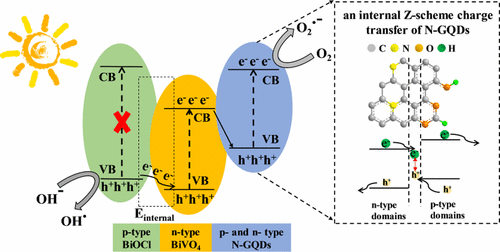当前位置:
X-MOL 学术
›
ACS Appl. Mater. Interfaces
›
论文详情
Our official English website, www.x-mol.net, welcomes your
feedback! (Note: you will need to create a separate account there.)
Boosting the Visible-Light Photoactivity of BiOCl/BiVO4/N-GQD Ternary Heterojunctions Based on Internal Z-Scheme Charge Transfer of N-GQDs: Simultaneous Band Gap Narrowing and Carrier Lifetime Prolonging
ACS Applied Materials & Interfaces ( IF 8.3 ) Pub Date : 2017-10-25 00:00:00 , DOI: 10.1021/acsami.7b14412 Mingyue Zhu 1 , Qian Liu 1 , Wei Chen 1 , Yuanyuan Yin 1 , Lan Ge 1 , Henan Li 1 , Kun Wang 1
ACS Applied Materials & Interfaces ( IF 8.3 ) Pub Date : 2017-10-25 00:00:00 , DOI: 10.1021/acsami.7b14412 Mingyue Zhu 1 , Qian Liu 1 , Wei Chen 1 , Yuanyuan Yin 1 , Lan Ge 1 , Henan Li 1 , Kun Wang 1
Affiliation

|
The efficient separation of photogenerated electron–hole pairs in photoactive materials is highly desired, allowing their transfer to specific sites for undergoing redox reaction in various applications. The construction of ternary heterojunctions is a practical strategy to enhance the migration of photogenerated electron that realizes the synergistic effect of multicomponents rather than the simple overlay of single component. Here, we demonstrate an available way to fabricate new BiOCl/BiVO4/nitrogen-doped graphene quantum dot (N-GQD) ternary heterojunctions that exhibit higher efficiency in charge separation than any binary heterojunction or pure material under visible-light irradiation. UV–vis diffuse reflectance spectroscopy demonstrated that the proposed BiOCl/BiVO4/N-GQD ternary heterojunctions possess the narrower band gap energy. More importantly, the ternary heterojunctions reveal the prolonged lifetime of photogenerated charges and enhanced the separation efficiency of photogenerated electron–hole pairs, which may be ascribed to sensitization based on an internal Z-scheme charge transfer at the interface of N-GQDs with oxygen functional groups. Furthermore, we examine the photoactive performance of proposed ternary heterojunctions in aqueous solution by using the photodegradation of bisphenol A as a model system and BiOCl/BiVO4/N-GQD ternary heterojunctions also display a dramatically enhanced photodegradation rate. The proposed charge separation and transfer process of BiOCl/BiVO4/N-GQD ternary heterojunctions for the enhanced photoactivity were deduced by electrochemical measurements, photoluminescence, and electron spin resonance. The results demonstrate that a Z-scheme charge process was formed between BiOCl/BiVO4 binary heterojunctions and N-GQDs, leading to an efficient charge carrier separation and strong photocatalytic ability. Notably, this work may assist in a better understanding of the role of N-GQDs in kinds of heterojunctions. Conceivably, it can be extended to fabricate other photocatalytic systems and photoelectrochemical platforms associated with photoactive materials.
中文翻译:

基于N-GQD内部Z方案电荷转移,提高BiOCl / BiVO 4 / N-GQD三元异质结的可见光光活性:同时带隙变窄和载流子寿命延长
人们迫切需要在光敏材料中有效分离光生电子-空穴对,从而使它们转移到特定位置,以便在各种应用中进行氧化还原反应。三元异质结的构建是一种增强光生电子迁移的实用策略,可实现多组分的协同效应,而不是单组分的简单叠加。在这里,我们展示了一种可利用的方法来制造新的BiOCl / BiVO 4 /氮掺杂的石墨烯量子点(N-GQD)三元异质结,在可见光照射下其电荷分离效率高于任何二元异质结或纯材料。紫外可见漫反射光谱法表明,建议的BiOCl / BiVO 4/ N-GQD三元异质结具有较窄的带隙能。更重要的是,三元异质结揭示了光生电荷的寿命延长并提高了光生电子-空穴对的分离效率,这可能归因于基于内部Z型电荷在N-GQDs与氧官能团的界面处转移的敏化作用。组。此外,我们通过使用双酚A的光降解作为模型系统研究了拟议的三元异质结在水溶液中的光活性性能,BiOCl / BiVO 4 / N-GQD三元异质结也显示出显着提高的光降解速率。拟议的BiOCl / BiVO 4电荷分离和转移过程通过电化学测量,光致发光和电子自旋共振推导了用于增强光活性的/ N-GQD三元异质结。结果表明,BiOCl / BiVO 4二元异质结与N-GQDs之间形成Z方案的电荷过程,从而导致有效的载流子分离和强大的光催化能力。值得注意的是,这项工作可能有助于更好地理解N-GQD在各种异质结中的作用。可以想象,它可以扩展到制造与光敏材料相关的其他光催化系统和光电化学平台。
更新日期:2017-10-26
中文翻译:

基于N-GQD内部Z方案电荷转移,提高BiOCl / BiVO 4 / N-GQD三元异质结的可见光光活性:同时带隙变窄和载流子寿命延长
人们迫切需要在光敏材料中有效分离光生电子-空穴对,从而使它们转移到特定位置,以便在各种应用中进行氧化还原反应。三元异质结的构建是一种增强光生电子迁移的实用策略,可实现多组分的协同效应,而不是单组分的简单叠加。在这里,我们展示了一种可利用的方法来制造新的BiOCl / BiVO 4 /氮掺杂的石墨烯量子点(N-GQD)三元异质结,在可见光照射下其电荷分离效率高于任何二元异质结或纯材料。紫外可见漫反射光谱法表明,建议的BiOCl / BiVO 4/ N-GQD三元异质结具有较窄的带隙能。更重要的是,三元异质结揭示了光生电荷的寿命延长并提高了光生电子-空穴对的分离效率,这可能归因于基于内部Z型电荷在N-GQDs与氧官能团的界面处转移的敏化作用。组。此外,我们通过使用双酚A的光降解作为模型系统研究了拟议的三元异质结在水溶液中的光活性性能,BiOCl / BiVO 4 / N-GQD三元异质结也显示出显着提高的光降解速率。拟议的BiOCl / BiVO 4电荷分离和转移过程通过电化学测量,光致发光和电子自旋共振推导了用于增强光活性的/ N-GQD三元异质结。结果表明,BiOCl / BiVO 4二元异质结与N-GQDs之间形成Z方案的电荷过程,从而导致有效的载流子分离和强大的光催化能力。值得注意的是,这项工作可能有助于更好地理解N-GQD在各种异质结中的作用。可以想象,它可以扩展到制造与光敏材料相关的其他光催化系统和光电化学平台。















































 京公网安备 11010802027423号
京公网安备 11010802027423号